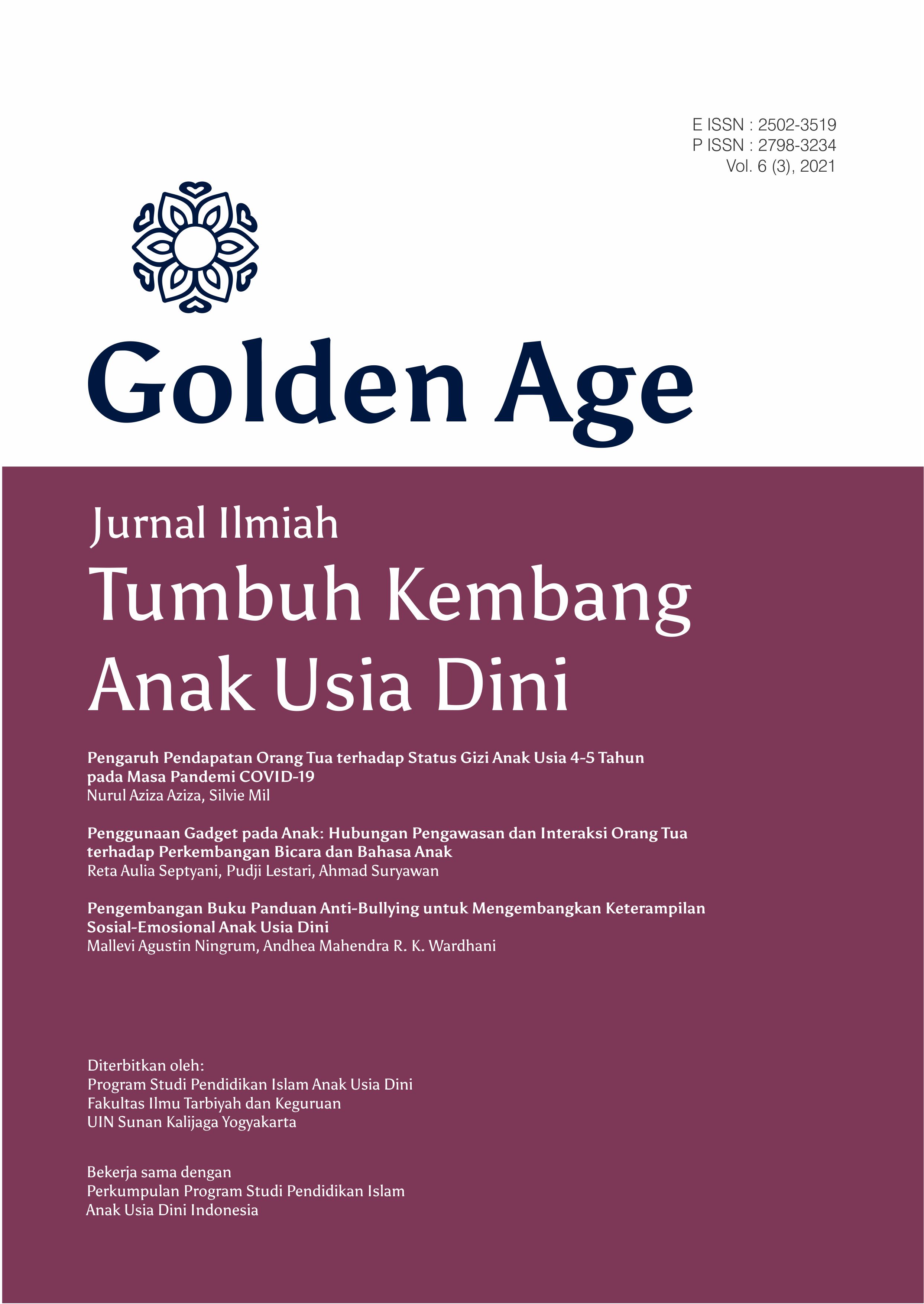3236
Views
3290
Pdf Bahasa Indonesia Views
 Open Access
Open Access
Penggunaan Gadget pada Anak: Hubungan Pengawasan dan Interaksi Orang Tua terhadap Perkembangan Bicara dan Bahasa Anak
Main Article Content
Abstract
Lack of supervision on gadgets can affect children's speech and language development, especially without interaction with parents. This study aimed to analyze the relationship between parental supervision and interaction with gadgets in children aged 4-5 years with the risk of speech and language development delays. The method used in this research is observational analytic. In analyzing the data, this study uses non-parametric statistical test Chi Square. The results of this study found that most respondents with speech and language development results are at risk of being late, rarely get supervision from their parents when using gadgets, namely, 23 respondents (79.31%), and most of the respondents' parents also said they did not interact when their children were using gadgets. gadgets as many as 23 respondents (79.31%). So that we get the results that there is a relationship between supervision (p value 0.001 < 0.05) and interaction (p value 0.000 < 0.05) of parents and children when using gadgets with children's speech and language development. Supervision and parental interaction on the use of gadgets in children are very important, considering the age of 4-5 years is included in the golden age where this period is a very sensitive developmental period because it will affect the future development of children. The findings in this study are expected to provide implications for parents to be able to increase supervision and interact with the use of gadgets in children.
Keywords:
Downloads
Metrics
Article Details
How to Cite
Copyright
Copyright Notice
Authors who publish with this journal agree to the following terms:
- Authors retain copyright and grant the journal the right of first publication with the work simultaneously licensed under a Creative Commons Attribution-NonCommercial 4.0 International License that allows others to share the work with an acknowledgment of the work's authorship and initial publication in this journal, provided that the work is not used for commercial purposes.
- Authors can enter into separate, additional contractual arrangements for the non-exclusive distribution of the journal's published version of the work (e.g., post it to an institutional repository or publish it in a book), with an acknowledgement of its initial publication in this journal.
- Authors are permitted and encouraged to post their work online (e.g., in institutional repositories or on their website) prior to and during the submission process, as it can lead to productive exchanges, as well as earlier and greater citation of published work.
Privacy Statement
The names and email addresses entered in this journal site will be used exclusively for the stated purposes of this journal and will not be made available for any other purpose or to any other party.
References
Alifiani, H., Nurhayati, N., & Ningsih, Y. (2019). Analisis Penggunaan Gadget Terhadap Pola Komunikasi Keluarga. Faletehan Health Journal, 6(2), 51–55. https://doi.org/10.33746/FHJ.V6I2.16
Chusna, P. A. (2017). Pengaruh Media Gadget pada Perkembangan Karakter Anak. Dinamika Penelitian: Media Komunikasi Penelitian Sosial Keagamaan, 17(2), 315–330. https://doi.org/10.21274/DINAMIKA.2017.17.2.315-330
Damayanti, R. A. M. (2017). Hubungan Penggunaan Gadget dengan Pencapaian Tugas Perkembangan Anak Usia Remaja Awal SDN di Kecamatan Godean. Universitas Muhammadiyah Yogyakarta.
Feldman, H. M. (2019). How young children learn language and speech: Implications of theory and evidence for clinical pediatric practice. Pediatrics in Review, 40(8), 411. https://doi.org/10.1542/PIR.2017-0325
Hirsh-Pasek, K., Zosh, J. M., Golinkoff, R. M., Gray, J. H., Robb, M. B., & Kaufman, J. (2015). Putting Education in “Educational” Apps: Lessons From the Science of Learning. Https://Doi.Org/10.1177/1529100615569721, 16(1), 3–34. https://doi.org/10.1177/1529100615569721
Kementerian Kesehatan Republik Indonesia. 2013. Pedoman Pelaksanaan Stimulasi, Deteksi dan Intervensi Dini Tumbuh Kembang Anak di Tingkat Pelayanan Kesehatan Dasar.
Khaironi, M. (2018). Perkembangan Anak Usia Dini. Jurnal Golden Age, 2(01), 01–12. https://doi.org/10.29408/GOLDENAGE.V2I01.739
Lepičnik-Vodopivec, J., & Samec, P. (2012). Advantages and Disadvantage of Information Communication Technology Usage for Four-Year-Old Children, and The Concequences of Its Usage for The Childrens’ Development. International Jounal of Humanities and Social Science, 2(3), 54–58.
Notoatmodjo, S. (2012). Metodologi Penelitian Kesehatan. PT. Rineka Cipta.
Palar, J. E., Onibala, F., & Oroh, W. (2018). Hubungan Peran Keluarga Dalam Menghindari Dampak Negatif Penggunaan Gadget pada Anak dengan Perilaku Anak dalam Penggunaan Gadget di Desa Kiawa 2 Barat Kecamatan Kawangkoan Utara. JURNAL KEPERAWATAN, 6(2), 8. https://ejournal.unsrat.ac.id/index.php/jkp/article/view/20646
Permenkes RI Nomor 66 Tahun 2014 tentang Pemantauan, Pertumbuhan, Perkembangan, dan Gangguan Tumbuh Kembang Anak.
Riyadi, Rusmil, K., & Effendi, S. H. (2014). Risiko Masalah Perkembangan dan Mental Emosional Anak yang Diasuh di Panti Asuhan Dibandingkan dengan Diasuh Orangtua Kandung. Majalah Kedokteran Bandung, 46(2), 118–124. https://doi.org/10.15395/MKB.V46N2.284
Soetjiningsih. (2008). Tumbuh Kembang Anak. EGC.
Suana, S., & Firdaus, F. (2014). Pola Asuh Orangtua Akan Meningkatkan Adaptasi Sosial Anak Prasekolah di RA Muslimat NU 202 Assa’adah Sukowati Bungah Gresik. Journal of Health Sciences, 7(2). https://doi.org/10.33086/JHS.V7I2.509
Sugiyono. (2017). Metode Penelitian Kuantitatif Kualitatif dan R&D. Alfabeta.
Suryana, D. (2016). Pendidikan Anak Usia Dini Stimulasi dan Aspek Perkembangan Anak. Kencana.
Susanto, A. (2014). Perkembangan Anak Usia Dini. Kencana Prenada Media Group.
Widiastiti, N. L. G. M., & Agustika, G. N. S. (2020). Intensitas Penggunaan Gadget oleh Anak Usia Dini ditinjau dari Pola Asuh Orang Tua di Kabupaten Badung. Jurnal Pendidikan Anak Usia Dini Undiksha, 8(2), 112–120. https://doi.org/10.23887/PAUD.V8I2.25179
Wulandari, D., & Hermiati, D. (2019). Deteksi Dini Gangguan Mental dan Emosional pada Anak yang Mengalami Kecanduan Gadget. Jurnal Keperawatan Silampari, 3(1), 382–392. https://doi.org/10.31539/JKS.V3I1.843
Yulsyofriend, Y., Anggraini, V., & Yeni, I. (2019). Dampak Gadget terhadap Perkembangan Bahasa Anak Usia Dini terhadap Perkembangan Bahasa Anak Usia Dini. Yaa Bunayya : Jurnal Pendidikan Anak Usia Dini, 3(1), 67–80. https://doi.org/10.24853/YBY.3.1.67-80
Zaini, M., & Soenarto, S. (2019). Persepsi Orangtua Terhadap Hadirnya Era Teknologi Digital di Kalangan Anak Usia Dini. Jurnal Obsesi : Jurnal Pendidikan Anak Usia Dini, 3(1), 264. https://doi.org/10.31004/obsesi.v3i1.127
Zubaidah, E. (2015). Perkembangan Bahasa Anak Usia Dini dan Teknik Pengembangannya di Sekolah. Cakrawala Pendidikan, 3(3), 459–479. https://doi.org/10.21831/cp.v3i3.7600




